Freddy Silva digs into the history, geology and archaeoastronomy of the Osirion of Abydos, Egypt—a monument he argues was built sometime before 10,000 BC and is mistakenly attributed to Seti I by academics.
When discussing ancient Egypt, much of the attention falls upon grandiose structures like the pyramids, because their superhuman scale is candy to the eye and humans are so easily seduced by the scale of things. Yet as mystery tradition teaches, the eye is easily deceived by scale to the detriment of seemingly trivial things that lead to greater illumination.
That said, it would be a travesty to describe the temple of Seti I at Abydos as trivial, for it is a beautifully preserved jewel of a sacred space. Certainly, ancient people treated the location with reverence, so much so that Abydos was already a thriving city by 5400 BC,1 and two thousand years later pre-dynastic pharaohs were still building shrines, temples and mortuaries there.
Seti I added his own masterpiece in the thirteenth century BC, during a reign that barely lasted a decade—an elegant temple featuring a series of interconnected halls and side chambers, covered from floor to ceiling in exquisite friezes. Still, people had long been coming here to witness another wonder.
Geological and archaeological considerations
Twelve thousand years ago, Abydos bore no resemblance to the partly parched, partly cultivated strip of land it is today. The climate was wetter, it sustained a verdant and lush landscape as far as the eye could see, and to the west where now lies an endless desert, there existed an inland sea, much of which drained into the Atlantic when the events that generated the Great Flood overhauled the terrain. A small saltwater lake at Siwa is all that remains. Referring to an older source, Diodorus of Sicily describes how it “disappeared from sight in the course of an earthquake, when those parts of it which lay toward the ocean were torn asunder,” leaving behind the Sahara.2
The course of the Nile was different, too. Its shore was five miles closer to Abydos, its waters reaching another kind of temple named after the Egyptian god of resurrection, Osiris—the Osirion. When it was cleared of debris, The Times of London described it as “a gigantic construction of about 100 feet in length and 60 feet in width, built with the most enormous stones that may be seen in Egypt.”3
In terms of construction and style, the temple bears no resemblance to Seti’s. It is stark yet hauntingly beautiful, one of the finest examples of simplicity and economy of line, expressed with heavyset blocks of red granite, one of the hardest rocks on Earth, ferried from a quarry two hundred miles away. The construction logistics pose a conundrum for any modern engineer, yet the Osirion belongs to a remote age. It was created with the sole intent of defying time.
The structure consists of two rows of columns connected by substantial architraves upon which a voluminous stone roof once stood. These are poised on a raised rectangular platform surrounded by a deep moat cut into the stone; two ascending staircases lead out of the water and onto the platform, where two sunken rectangular pools lie.
The surrounding courtyard is one massive and impenetrable wall made of 25-foot thick red sandstone, fitted without mortar, with corner stones cut and angled much like they are in Cuzco. Seventeen side chambers are meticulously cut into the wall and face the central platform.4 The plan of the courtyard bears a passing resemblance to the head of Pachacamac carved above the Sun Door at Tiwanaku. It’s a passing observation for sure, but the same can be said for the knobs carved on sections of the courtyard wall, for they are almost identical to those in Andean temples.
There are no inscriptions inside the Osirion, no dedications, and no name to identify its creator—only a set of hieroglyphs carved into the wall adjoining Seti’s temple, no doubt put there during the pharaoh’s reign.
Until recently the Osirion was believed to be a type of underground chamber fitted inside hollowed bedrock, an extension of Seti’s temple. If so, it represents a complete departure from standard temple design. However, a geological appraisal contradicts this opinion. In ancient times the level of the Nile was fifty feet lower than today, its course seven miles closer to and beside the Osirion. When North Africa was subjected to major flooding between 10,500-8000 BC, layers of Nile silt gradually compacted and rose inch by inch until they surrounded and covered the Osirion. In other words, the temple was originally a freestanding feature on the floodplain.5
Legend has it that people once reached the Osirion and navigated its interior by boat, an opinion expressed by Henri Frankfort, one of the early archaeologists at Abydos.6 But as the Nile crept eastwards, it eventually became necessary to connect the Osirion to the river with a long canal.7
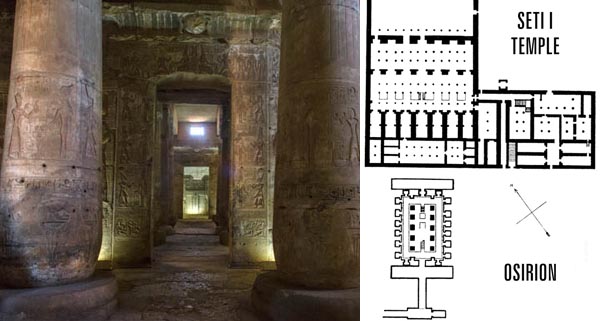
Seti I’s temple bears no visual relationship to the Osirion, and its plan veers abruptly to the left, in violation of temple protocol.
In this regard, the Osirion has two counterparts downriver at Giza—the Sphynx Temple and the Valley Temple, all constructed with identical megalithic blocks of red granite (those of the Sphynx Temple were looted for building material) using the same clean, graphic layout, devoid of inscription. The Giza temples were also reached by boat when the waters of the Nile lapped at their respective entrances. The intermediate walls of the Valley Temple are made from massive blocks of limestone quarried from the Sphynx enclosure next door and are clearly eroded by water, lots of water. Since it has been convincingly argued that the Sphynx itself was carved to face its counterpart in the sky, the constellation Leo on the spring equinox c.10,400 BC, ostensibly the two sites are contemporaries of each other.8 Furthermore, during the epoch prior to 10,000 BC, the enclosure in which this lion sits was also weathered by extensive flooding and rainfall, when northeast Africa had a pluvial climate.9 Thus by weathering and design alone, the Osirion, Sphynx Temple and Valley Temple were built contemporaneously.
Returning to the Osirion, there is the question of why so many temples and shrines appear in its vicinity to which none relate, as though the Osirion was no longer visible by pre-dynastic times, so when pharaohs went to mark their devotion they were essentially honouring the sanctity of place. By the time Seti I came to build his temple—one of the last to be erected—he may have rediscovered the Osirion because his temple follows the same orientation, but stops short of the underground structure before resuming to the left and creating an L-shape, forcing the most holy of chapels to be placed sideways to the body of the temple, a complete violation of temple protocol.10 The only rational explanation for such a drastic measure is that Seti’s superimposed building broke through the chamber beneath during construction.
Could the enigmatic structure be a remnant of an antediluvian age? With its raised platform surrounded by a water channel, the Osirion can be regarded as a recreation of the primeval island of the gods in stone, an artificial representation of the original home from which the gods emerged. To determine exactly when it was built we must turn to archaeoastronomy.
Archaeoastrononomical and mythological considerations
Time and again I have stood dumbstruck in the Osirion. Its orientation has puzzled me, for it neither faces the solstices or equinox, nor the pole star or any obvious object in the sky. Myth states that this is a resting place of Osiris, even if the association, as in so many cases of ancient lore, is metaphorical. Osiris is the classic representation of the hero who is dismembered before ascending the Milky Way to reach the origin of souls—typically the Pole Star or the belt of Orion—and whilst in the Otherworld is reconstituted by his consort, Isis.
A look at the night sky at the time of Seti I produces no relationship to any stellar object. It seems the pharaoh broke yet another convention by ignoring the sky-ground dualism essential to the foundation of the temple and its function as a mirror image of the sky. Seti was, however, an astute student of temple protocol and would not have made such an obvious mistake. Since his temple is aligned to the same axis as the Osirion, it follows that he may have attempted to revive its eminence.
I turned my focus to Orion, the constellation with which Osiris is intimately associated. Perhaps this obvious clue would yield a sky-ground relationship. But no such relationship exists, not unless the Earth was upside down 14,000 years ago.
Only in the epoch of 10,000 BC do connections begin emerge, for the constellation Cygnus appears in full upright ascent over the horizon in conjunction with the axis of the temple, the entrance framing its brightest star, Deneb. As does the Milky Way, forming a vertical river for Cygnus to sail on, towards the vault of heaven. The correlation took place on the Spring Equinox c. 10,500 BC, and again on the Winter Solstice that year.
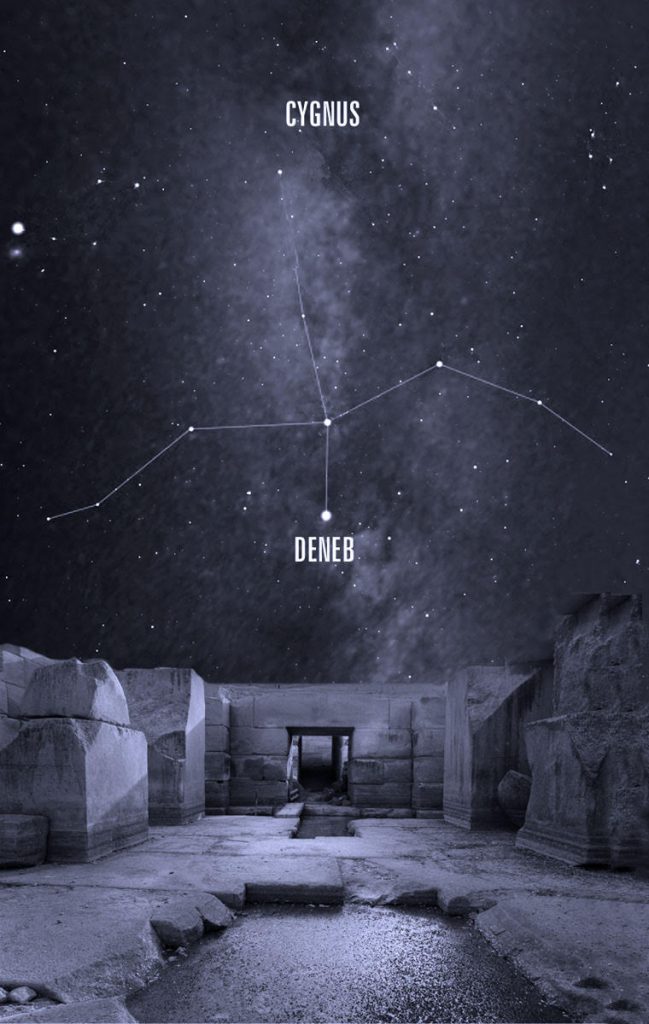
Deneb in Cygnus rides a vertical Milky Way, as seen from the entrance on the winter solstice c.10,500 BC (rear of site pictured).
By way of validation, the sky goddess Nut, who is identified with the Milky Way, is painted as a naked female spread across the sky on the ceiling of the Osirion’s northeastern chamber, her legs formed by the bifurcation at Deneb in Cygnus.11 The symbol couldn’t be more apt. Cygnus itself was regarded as both a swan and as a kite hawk, and it is likely that Egyptian references to the “kite of Osiris” may have had this constellation in mind. Osiris’ bride Isis, who took on the form of a kite hawk when resurrecting souls, is depicted with outstretched wings as a symbol of protection, and to demonstrate her ability to fan the breath of immortality into those whom she oversaw, particularly her consort Osiris.
For immortality to occur, ancient Egyptian texts state that the soul of the hero had to reside in the pole star, which was regarded by ancient cultures as the region of regeneration, a place in the sky protected by seven great akus (souls), each represented by the seven circumpolar stars, Deneb being one of them.12 Egyptologist Toby Wilkinson explains this in the context of Egyptian ideology:
“Circumpolar stars are a very good metaphor for the afterlife because when viewed, they never seem to set: they simply rotate around the pole star. They are the undying stars, or in Egyptian terminology, the Indestructibles, a perfect destination for the soul.”13
The Indestructibles or ikhemu-sek (the ones not knowing destruction) was a name created by ancient Egyptian astronomers, although the idea that these stars protect a portal of regeneration is shared by extant indigenous cultures.14 Interestingly, Cygnus appears to occupy a region in space where such regeneration might occur. Research by NASA reveals this constellation to be a source of the most energetic and penetrating form of light—gamma rays. More to the point, it is one of our Galaxy’s richest-known stellar construction zones. In essence, Cygnus is a star-forming region.15 Perhaps it is for this reason that temples of the magnitude of the Osirion are referred to as places where an individual goes to be transformed into a god or bright star.
Indestructible? Portal of regeneration? What apt epiteths for a temple named for the god of rebirth and designed to outlast time! Incidentally the derivative of aku is akh—a person filled with inner spiritual radiance, a Shining One—from which is derived the term ahu, the name given to the ceremonial stone platforms of Easter Island.
‘Shining Ones’ was also the nickname given to the pre-flood gods of Egypt, the Aku Shemsu Hor, the Urukehu gods of New Zealand and Easter Island, Viracocha and his seven Hayhuaypanti, and the Anunaki sages. Could any of these antediluvian seafaring gods have been responsible for the Osirion? Probably, based on there being a direct correlation between the Osirion and the position of Deneb c. 10,500 BC, when this brightest of stars not only rose along the axis of the temple but, due to the effects of precession, had also taken up its position as one of the Indestructibles.
References
1. Goenka, Himanshu. Egypt Ancient History: 7300-year old city Found in New Excavation Along the Nile, IBT Times, 11/24/2016.
2. Diodorus of Sicily III, 55, trans C.H. Oldfather, Loeb Classical Library, 1939.
3. The Times, London, 17 March 1914.
4. Frankfort, Henri. The Cenotaph of Seti I at Abydos, 39th Memoir of the Egypt Exploration Society, London, 1933, p.18.
5. Also stated by John Anthony West in The Traveller’s Key to Ancient Egypt: A Guide to the Sacred Places of Ancient Egypt, Quest Books, Wheaton, 1996, p.392.
6. Frankfort, op cit.
7. Strabo, Geography, vol. VIII, p.111.
8. Bauval and Gilbert, op cit.
9. West, John Anthony. Serpent In The Sky, Quest Books, Wheaton, p.184-242.
10. ie. West, op cit.
11. Wells, Ronald A., and Christopher Walker, ed. Astronomy Before the Telescope, St. Martins Press, New York, 1996, p.29–32.
12. Massey, Gerald, Ancient Egypt: The Light of the World, Vol. II, T. Fisher Unwin, London, 1907, p.613-4.
13. “Pyramids Seen as Stairways to Heaven”, Tim Radford, The Guardian, May 14, 2001.
14. Wells and Walker, op cit, p. 35.
15. In The Heart Of Cygnus, NASA’s Fermi Reveals A Cosmic-ray Cocoon, Nov. 28, 2011.
16. Higgins, W.H., Stars and Constellations, p.22.





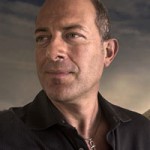
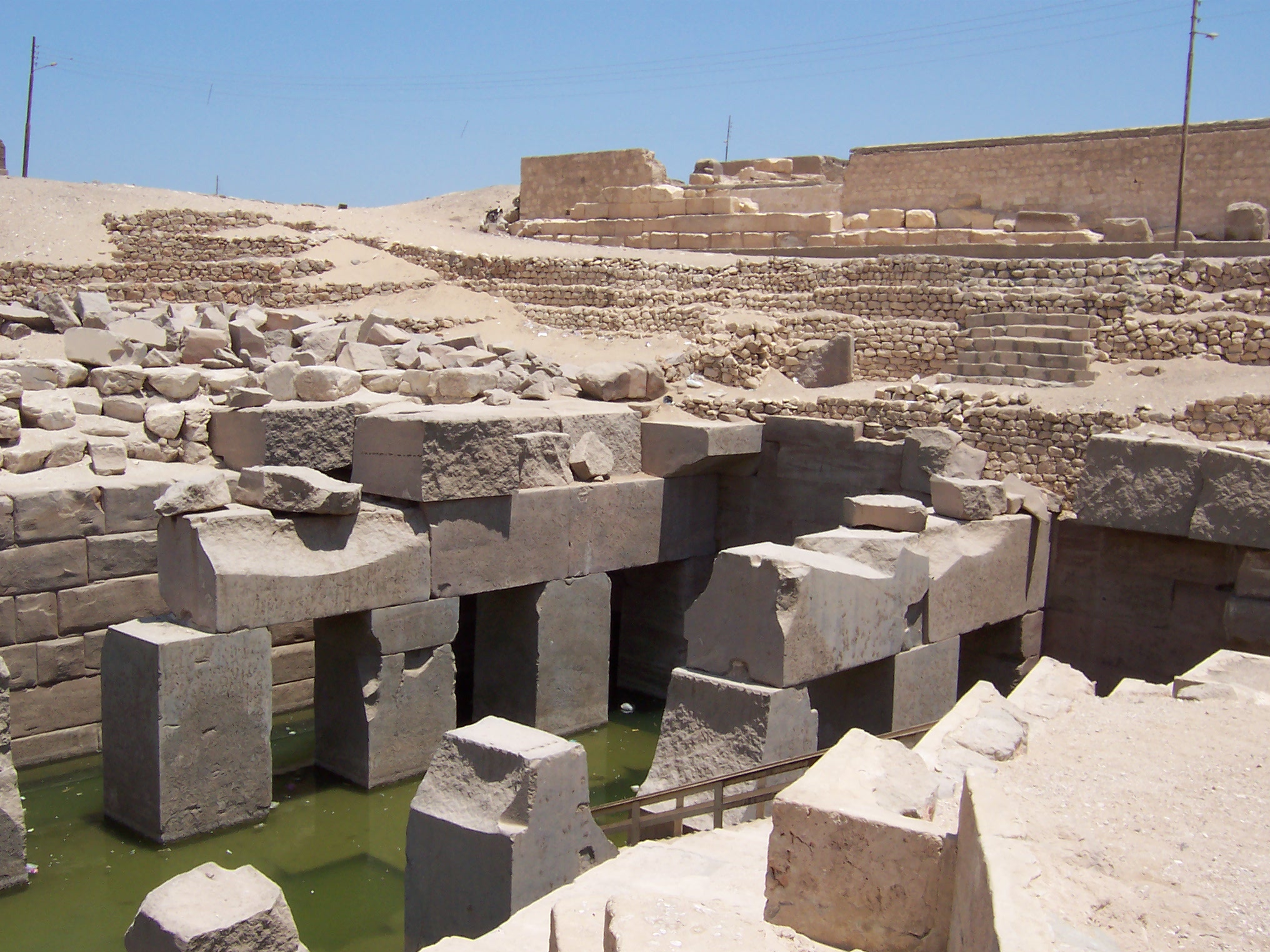







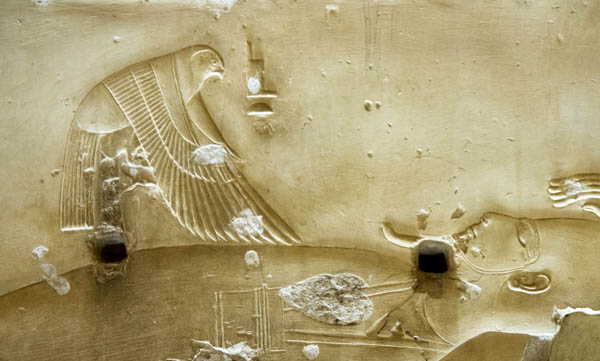

Hello Freddy,
You might care to read my guide on the Osireion; by no means a well understood structure, the evidence we do have, point to Seti being its creator.
https://www.academia.edu/37568156/The_Osireion_A_Laymans_Guide
Thank you for writing such an excellent document. I appreciate your professionalism and thorough research!
The giza pyramids were built on top of ancient aquifers as were other pyramids such as the El Castillo pyramid of Chichen Itza.The aquifers supply a current which is magnified and channeled upwards through the pyramids indicating to the celestial Gods of Cygnus that their subjects ot Earth have water security and are therefore able to tend to the important crops and plants left in mans custody.(Gifts given to man to protect such as chocolate, pomegranate and wheat until the Gods return.)The now dry aquifers of the Giza Plateau maybe ringing alarm bells?
On a web site, when you click on an image, it is supposed to present a larger version of the image, not a smaller one. The site really does need improvement, especially considering the importance of the subject matter.